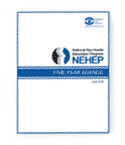About NEHEP
NEHEP Five-Year Agenda
The Five-Year Agenda outlines the focus of NEHEP activities and program goals over the next five years. It incorporates input and guidance from the Planning Committee and its Subcommittees, with ultimate guidance and approval from the National Advisory Eye Council, the advisory group to the National Eye Institute. The agenda is built upon best practices, current research, and scientific literature. NEHEP plans to accomplish this Agenda by the following:
- Setting results-oriented program priorities.
- Providing a framework for developing and implementing activities for people at higher risk.
- Building NEHEP Partnership support for the program objectives.
- Establishing and implementing a comprehensive evaluation plan to assess the effectiveness of program activities.
Priority Areas
The goals and objectives noted within the Agenda reflect five major areas of concentration to further the overall NEHEP goal. Each priority area has specific goals, objectives, and calls to action. The five priority areas are listed below:
- Priority Area One: The National Eye Health Education Program (NEHEP).
- Priority Area Two: The NEHEP Partnership.
- Priority Area Three: Glaucoma, Diabetic Eye Disease, and Low Vision Education Programs.
- Priority Area Four: Development of new education programs targeted to older adults on the importance of early detection and timely treatment of age-related eye diseases.
- Priority Area Five: Evidence-based education programs, as dictated by science and the needs of the American public.
Each of these priority areas of the Agenda not only serves as a roadmap to guide program efforts but also outlines key efforts to work with various organizations and engage the support of eye and other health care professionals in educating the public.
Download the NEHEP Five-Year Agenda PDF* 877KB
*PDF files require the free Adobe® Reader® software for viewing. Attention people with visual disabilities: please visit access.adobe.com to work more effectively with PDF files. On this website, a file size will be indicated when exceeding 1M. Need help working with PDF files?

